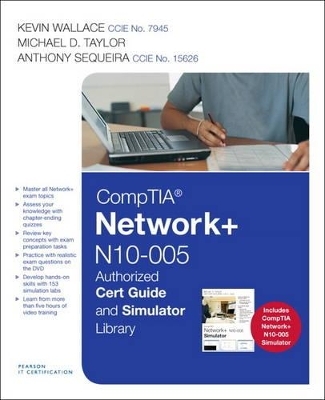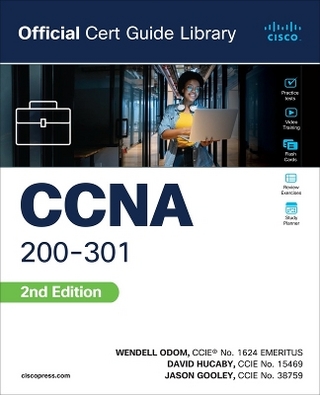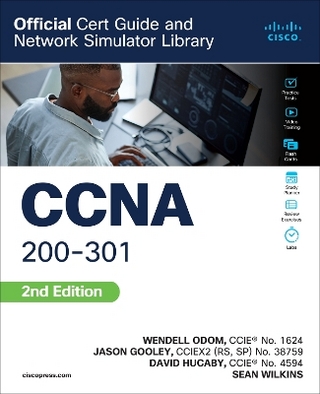
CompTIA Network+ N10-005 Cert Guide and Simulator Library
Pearson IT Certification
978-0-7897-5177-5 (ISBN)
- Titel ist leider vergriffen;
keine Neuauflage - Artikel merken
Book: A comprehensive, fully revised book for complete lessons and reference: CompTIA Network+ N10-005 Authorized Cert Guide, ISBN 9780789748218
Practice Test : A CD with a state of the art practice test featuring customizable practice questions
Simulator and Labs: A state of the art Network Simulator with 153 hands-on, step-by-step labs covering the full range of Network+ exam topics: CompTIA Network+ N10-005 Simulator, ISBN 9780789749154
Video Training: More than five and a half hours of expert-led video training, walking through the skills and concepts necessary for passing the Network+ exam
Limited Time Offer: Buy CompTIA Network+ N10-005 Authorized Cert Guide and Simulator Library and receive a 10% off discount code for the CompTIA Network+ N10-005 exam. To receive your 10% off discount code:
Register your product at pearsonITcertification.com/register
Follow the instructions
Go to your Account page and click on “Access Bonus Content”
This network simulator and authorized study guide help you master all the topics on the Network+ N10-005 exam, including:
Computer networking fundamentals
OSI Model
Network components
Ethernet
IP addressing
Routing traffic
Wide Area Networks (WANs)
Wireless LANs
Network performance
Command-Line utilities
Network management
Network security
Troubleshooting
About the CompTIA Network+ N10-005 Simulator
Gain hands-on experience for the CompTIA Network+ N10-005 exam without having to invest heavily in hardware, software, or other equipment with this Network+ Simulator from Pearson IT Certification, a leader in IT Certification learning and a CompTIA Authorized Platinum Partner.
The Simulator Series from Pearson IT Certification are the most effective simulators for hands-on skills enhancement and is the perfect learning product to help you prepare for CompTIA’s newly introduced performance-based questions.
This state-of-the-art, interactive simulation software presents you with more than 150 challenging labs that help you learn by doing, which is the most effective method of learning. Experience realistic operating system and network device response as you work through each of the labs. Manipulate cables and other hardware and organize network devices on network topology maps. All Network+ N10-005 exam topics are covered, including networking concepts, network installation and configuration, network media and topologies, network management, and network security.
The labs are divided into five different types. Matching labs help you develop a mental map of concepts, enhancing retention and recall. Drag and Drop exercises allow you to work with physical cables and other equipment as well as network designs. Command Line Interface (CLI) labs allow you to get some hands-on experience configuring Cisco routers and switches. Graphical User Interface (GUI) labs allow you to work through common Windows 7, Windows Server 2008, Linux, and Lynksys router configuration tasks. Worksheet exercises help you master numbering system conversions. Labs conclude with Think About It sections to help you develop critical thinking skills and delve deeper into the concepts you are learning in the lab activities. You can save your grades on each lab in PDF format, and the software tracks your progress on each lab, so you always know exactly where you are in your studies.
In addition to the wealth of hands-on exercises, this software comes complete with more than four hours of video training by expert instructor Anthony Sequeira.
About the CompTIA Network+ N10-005 Authorized Cert Guide
In CompTIA Network+ N10-005 Authorized Cert Guide, best-selling author and expert instructor Kevin Wallace shares preparation hints and test-taking tips, helping you identify areas of weakness and improve both your conceptual knowledge and hands-on skills. The book presents you with an organized test preparation routine through the use of proven series elements and techniques. Exam topic lists make referencing easy. Chapter-ending Exam Preparation Tasks help you drill on key concepts you must know thoroughly. Review questions help you assess your knowledge, and a final preparation chapter guides you through tools and resources to help you craft your final study plan.
The companion DVD contains the powerful Pearson IT Certification Practice Test engine, complete with hundreds of exam-realistic questions. The assessment engine offers you a wealth of customization options and reporting features, laying out a complete assessment of your knowledge to help you focus your study where it is needed most. The DVD also contains more than 90 minutes of personal video mentoring from the author.
CompTIA Network+ N10-005 Simulator minimum system requirements:
Microsoft Windows XP (SP2/SP3), Windows Vista (32-bit/64-bit) with SP1, or Windows 7 (32-bit/64-bit), Mac OS X 10.6, 10.7; Intel® Pentium® III 1GHz or faster processor (Win) or Intel Core™ Duo 1.83GHz or faster processor (Mac); 512 MB RAM (1 GB Recommended);1.5 GB Hard Disk Space; Adobe Acrobat Reader version 8.0 or higher.
Pearson IT Certification Practice Test minimum system requirements:
Windows XP (SP3), Windows Vista (SP2), or Windows 7; Microsoft .NET Framework 4.0 Client; Pentium class 1GHz processor (or equivalent); 512 MB RAM; 650 MB disc space plus 50 MB for each downloaded practice exam.
Book TOC:
1. Introducing Computer Networks
2. Dissecting the OSI Model
3. Identifying Network Components
4. Connecting Network Components
5. Understanding Ethernet
6. Communicating over the Network with TCP/IP
7. Introducing Wide Area Networks
8. Connecting Wirelessly
9. Optimizing Network Performance
10. Troubleshooting Network Issues
11. Using Command-Line Utilities
12. Managing a Network
13. Securing a Network
Network+ Simulator TOC:
Hands-on Lab Activities:
1.0: Networking Concepts
1. TCP/IP Model Layer Matching
2. TCP/IP Protocols and Functions
3. OSI Model Layer Functions
4. Transport Layer Header Fields
5. Network Layer Header Fields
6. Data Link Layer Fields
7. Distinguishing between Applications and Protocols
8. OSI Model Layer and Network Devices
9. Understanding Data Encapsulation
10. Application Layer Network Server Descriptions
11. Reference Model Terminology
12. Network Numbering Systems - Conversions
13. Network Numbering Systems - Adding
14. Binary Adding
15. Network Numbering Review Practice
16. Identify Parts of an IPv4 and IPv6 Address
17. Network Addressing Terminology
18. IPv4 Address Types and Classes
19. Calculating the Number of Hosts in a Given Network
20. Discovering the Network Number for a Given Host
21. IPv6 Addressing Terminology
22. IPv6 Header Field Descriptions
23. IPv6 Header Field Positioning
24. IPv6 Address Format Prefix Types and Descriptions
25. Truncating IPv6 Addresses
26. IPv6 Network Numbering
27. Summary Review of Header Fields
28.Determining if Two Computers Are on the Same Logical Network in IPv4
29. IPv4 Allocating Bits for Network Addresses
30. IPv4 - Create a Custom Subnet Mask (Part 1 )
31. IPv4 - Creating a Custom Subnet Mask (Part 2)
32. IPv4 - Using Variable Length Subnet Masks
33. IPv4 Scenario-based Test Applet
34.Intermediate IPv4 Addressing Practice 1
35.Intermediate IPv4 Addressing Practice 2
36. IPv4 Advanced - Route Aggregation Planning
37. Routing Protocols
38. Routed Protocols
39. Matching Well-Known Port Numbers
40. Network Application Protocols
41. Configuring an FTP Server
42. Configuring an FTP Client
43. Configuring an Email Client
44. Domain Name Services Terminology
45. Configuring Static Hostname Resolution on a Workstation
46. Using NSLookup for DNS Troubleshooting
47. DNS Troubleshooting Simulation
48. Reordering Troubleshooting Steps
49. Troubleshooting Practice
50. Virtualization Terminology
51. Workstation Virtualization
52. Server Virtualization Planning
53. Contrast Virtualization Technologies and Services
2.0 Network Installation and Configuration
54. Connect to a Switch Console Port and Set the Hostname
55. Connect to a Switch and Reconfigure the Hostname and Password
56. Configure an IP Address on a Switch with a Default Gateway
57. Switch Management via Telnet
58. Understanding Switching Loops
59. Choosing and Configuring a Root Switch
60. Configuring Switched VLANs and Trunk Ports
61. Configuring Port Security
62. Spanning Tree Port Identification
63. Connecting to the Router’s Console Port
64. Configuring Hostname and Passwords
65. Configuring an Ethernet Interface on a Router
66. Using the Show Run Command to Read the Current Configuration
67. 'show' Commands Useful for Troubleshooting Common Router Problems
68. Connecting Two Routers to Each Other
69. Verifying a Router-to-Router Connection with Cisco Discovery Protocol
70. Saving the Router or Switch Configuration
71.: Static and Default Routing
72. Configuring InterVLAN Routing
73. Configuring Dynamic Routing
74. Reading a Routing Table
75. Configure Small Office/Home Office Router for Basic Operation
76. Matching Antenna Types
77. Wireless Antenna Placement
78. Using a Static Address on a Small Office/Home Office Router
79. DHCP Technology
80. Details of DHCP Client Address Configuration Process
81. Configuring Small Office/Home Office Router- Network User Security Settings
82. Manually Configuring Wireless Signals on a Small Office/Home Office Router
83. Configuring a Wireless USB Network Adapter to Connect to a Wireless Router
84. Using NetSh to scan for wireless networks
85. Configuring a Network Adapter with an IPv6 Address
86. Configuring Access Restrictions on a Small Business/Home Office Router
87. Configuring Port Forwarding to Local Services on a Small Office/Home Office Router
88. Address Translation Terminology
89. Configuring a Connection to a Network Printer
90. Mapping a Network Drive to the Desktop
91. Configuring a Client Network Adapter with an IPv4 Address
3.0 Network Media and Topologies
92. Media Types and Properties
93. Matching Transceiver Port Functions for Category 5 Cabling
94. Matching Cable to Wire Length
95. Create a Straight Cable and Test It
96. Create a Crossover Cable
97. Configuring a Network Adapter with an IP Address
98. Making a Direct Connection Between Two PCs
99. Verify a Data Link Connection from a Computer to a Network
100. Demonstrate Appropriate Wired Network Connections Between Device Pairs
101. Drag and Drop Appropriate Cables into a Topology
102. Fiber Optic Cabling, Connectors, and Uses
103. Connecting Campus Area Distribution Facilities to Each Other
104. Matching Wireless Standards and Terminology
105. Matching DSL types with descriptions
106. Matching Broadband Terminology with Descriptions
107. Wide Area Networking Technology
108. Network Topologies
109. Network Types
110. Identify Common Cat5 Wiring Problems
111. IEEE Local Area Network Wire Standards
112. IEEE LAN Standards and Technologies
113. Components of Wiring Distribution Systems
114. Network Infrastructure Component Placement
4.0 Network Management
115. Functions of Network Appliances/Management Software
116. Hardware Tools and Functions
117. Use of the ipconfig Command with Available Options
118. Using ipconfig to Discover Network Settings
119. Using ping to Troubleshoot Connectivity
120. Using extended ping (Command Switches) to Troubleshoot Connectivity
121. Using ARP to Discover a MAC Address
122. Using tracert to Troubleshoot Connectivity
123. Using netstat to Troubleshoot Connectivity
124. Using ipconfig, ping, arp, and tracert Together to Troubleshoot Connectivity
125. Using the route print Command
126. Using Basic Linux Troubleshooting Commands
127. Identifying Troubleshooting Commands to Use for Various Tasks
128. Matching Command Output to Commands
129. Understanding SNMP Functions and Terminology
130. Identifying Network Monitoring Databases and Logs Based on Need
131. Network Documentation
132. Identifying Network Performance Terminology
5.0 Network Security
133. Security Terminology and Descriptions
134. Wireless Security Terminology
135. Remote Access Terminology
136. VPN Terminology
137. Tunneling Terminology
138. Matching Authentication Terminology with Descriptions
139. Password and Authentication Methodology
140. Creating Network Users on a Domain Controller
141. Secure Protocols vs. Unsecure Protocols
142. Creating a Local Login Database to Secure Access to a Router
143. Network Vulnerabilities the Hacker and Network Admin Perspectives
144. Types of Network Threats and Attacks
145. Network Protection Mechanisms
146. Firewall Terminology and Functions
147. Folder Sharing and Security
148. Resource Security through a Domain Controller
149. Data Storage and Disaster Recovery Concepts
150. Using Encrypting File System (EFS) to Encrypt Data Files
151. Configuring a VPN Client
152. Small Office/Home Office Router: Wireless MAC Access Security
153. Security Appliance Terminology and Methods
Video Lessons:
Lesson 1: The OSI and TCP/IP Models
Lesson 2: IPv4 and IPv6 Addressing
Lesson 3: IPv4 Subnetting
Lesson 4: Router and Switch Setup
Lesson 5: routing and Routing Protocols
Lesson 6: Common Networking Problems
Lesson 7: Network Troubleshooting
Lesson 8: Virtual Networking
Lesson 9: Wireless Networking
Lesson 10: Networking Media
Lesson 11: Networking Topologies
Lesson 12: Network Management Tools and Techniques
Lesson 13: SNMP
Lesson 14: Quality of Service (QoS)
Lesson 15: Common Network Attacks and Mitigation
Lesson 16: Securing Wireless
Lesson 17: Firewalls and Intrusion Prevention Systems
Lesson 18: VPNs
| Erscheint lt. Verlag | 13.6.2013 |
|---|---|
| Verlagsort | Upper Saddle River |
| Sprache | englisch |
| Maße | 100 x 100 mm |
| Gewicht | 100 g |
| Themenwelt | Mathematik / Informatik ► Informatik ► Netzwerke |
| Informatik ► Weitere Themen ► Zertifizierung | |
| ISBN-10 | 0-7897-5177-1 / 0789751771 |
| ISBN-13 | 978-0-7897-5177-5 / 9780789751775 |
| Zustand | Neuware |
| Haben Sie eine Frage zum Produkt? |
aus dem Bereich


